By Mike Tanner, Photos By Kevin Gaydosh
POWELL'S POINT, NC -- In this age of supersized golf courses that stretch out to well over 7,000 yards of tortuous fairways, cavernous bunkers and humpbacked roller coaster greens, it's nice to know that places like The Pointe Golf Club are out there.
Located a little more than three miles from the Wright Memorial Bridge on US 158, The Pointe just may be the most player-friendly layout in this neck of the woods.
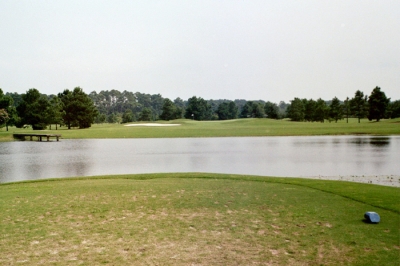 |
| The green of the par three 3rd hole beckons from across the pond, more of a psychological than physical challenge. |
"You don't feel like you've gone 10 rounds with a heavyweight," said Head Professional Doug Kinser as he described The Pointe's appeal. "People come back in after playing and talk about having a great round and how much they like the course."
Playability is one thing that people talk about when discussing The Pointe, but the course's local reputation rests on its slick A-1 bentgrass greens.
"From day one people have associated fast greens and great conditioning with us," Kinser said when asked about the putting surfaces. He went on to add that The Pointe was one of the first U.S. golf courses to feature the hybrid strain of grass on all 18 holes.
That's not a total surprise considering the fact that The Pointe's owners also operate one of the region's major turfgrass companies. According to Kinser, " Keith Hall (president of United Turfgrass) used A-1 bentgrass, which was new at the time, because he wanted to offer golfers a higher level quality of putting surface than what was generally available at the time The Pointe opened."
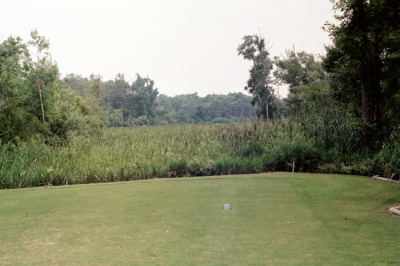 |
| Visually intimidating, the tee shot on the 12th hole requires a carry of only about 150 yards. |
Kinser went on to add that, "Mr. Hall's knowledge of turfgrass is very helpful. He's always observing conditions -- on the tees and fairways, even the rough."
The Pointe welcomed its first players in 1995, on the site of -- no surprise again -- a former sod field. Kinser was on hand from the beginning, working as an assistant to the course's first head professional, and he remembers watching architect Russell Breeden at work.
"He's old-school," said Kinser. "He was on the tractor himself, shaping the course."
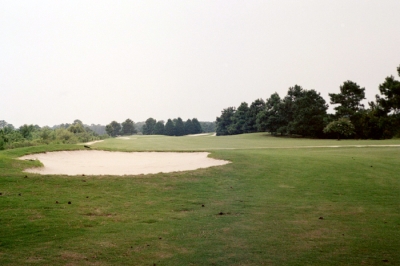 |
| Trouble left and right, as seen on the par five 8th hole, is rare at The Pointe. |
Breeden, a protégé of Scottish-born golf architect Fred Findlay, has designed more than 70 golf courses, mainly in the Southeast. His lengthy resume of fun-to-play, easy-to-maintain layouts includes The Pointe's sister course, The Carolina Club, and Sleepy Hole in Suffolk, Virginia.
The golf course that Breeden created on the old sod farm has a little touch of the auld sod of Scotland. There aren't a lot of trees and he didn't move a lot of dirt. The major defenses against low scores are the ubiquitous Outer Banks wind and the greens.
The putting surfaces are generally small in size and open to run-up shots in most cases. The A-1 bentgrass features a dense, fine leaf texture that grows straight up and produces virtually no grain. On the day of my visit, late in a summer season that brought higher than normal amounts of rain to the region, the greens showed signs of stress, but were still uniform in speed.
Most of the hazards are off to the side, with a few notable exceptions. Shots that fail to find the Tifway Bermudagrass fairways don't get lost in a tangle of sandy, scrub-infested wasteland. Mishits can often be located and put back into play; this alone contributes to The Pointe's expeditious pace of play.
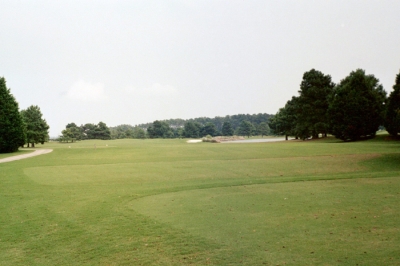 |
| The opening hole welcomes players with a wide fairway and hazards off to the side. |
The first hole at The Pointe, a 528-yard, par-5, greets players with a wide landing area bordered on the right by a long, undulating bunker and a wide pond. The fairway doglegs to the right and offers a choice: Play away from the water and leave yourself a wedge shot to the green, or haul out a fairway metal and go for the green over the pond.
The next five holes parallel each other in alternate directions that guarantee that the wind comes at you from different directions. Hole number three is a par-3 that can be stretched to 194 yards and features an unusual water hazard. Instead of occupying a position close to the green, the water extends from the front of the tee to a point about halfway to the putting surface. The only way you can lose a ball in the hazard is if you totally flub your tee shot.
The last hole in this series, number 6, a 454-yard par-4, calls for a drive over a pond and fairway bunker on the right, followed by an accurate iron shot to a kidney-shaped green set at a left-to-right angle to the fairway.
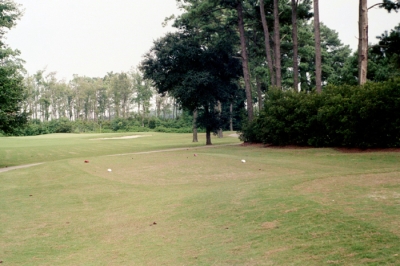 |
| The par three 7th hole occupies a secluded corner of the course near the Currituck Sound. |
The par-3 seventh presents a change of pace from the preceding back-and-forth fairways. Set in a clearing surrounded by tall pine trees with the Currituck Sound in the distance behind it, the hole is in its own 151-yard long little world. The green presents an oblique target bracketed by a bunker in front and a small hump that extends onto the putting surface from behind.
Following this pleasant little gem, you are confronted by The Pointe's number-one handicap hole. An exception to the forgivingly wide fairways that have come before it, the 459-yard, par-5 is narrow from tee to green. Beginning with the tee shot that must fly from left to right around a nearly 90-degree dogleg, keeping the ball in play is paramount. The green is skinny too, with pronounced plateaus front and rear, separated by a deep swale.
The back nine starts with a dogleg-right par-5 that seems innocuous enough. Only 537-yards from the tips, the hole may tempt stronger players to run their second shots onto the green, but a small mound subtly positioned at the green's entrance can easily deflect ground-hugging shots into bunkers on both sides of the putting surface.
Number twelve is a major departure from The Pointe's usual positioning of hazards to the side of the line of play. The scenic par-4 demands a forced carry of 150 yards over wetlands to a fairway that slopes left toward a wooded area that can block your approach to one of the largest greens on the course. The hole is only 348 yards from the back tees, but it can jump up and bite you in a hurry.
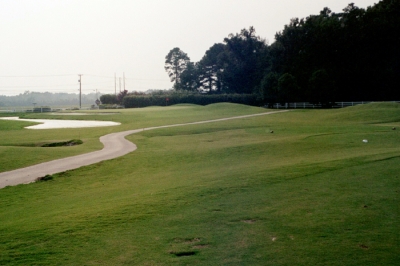 |
| The 17th green provides a tantalizing glimpse of golf to passersby on their way to the beaches. |
The last four holes at The Pointe are located along the entrance road, a little removed from the rest of the course. Number sixteen is pretty little par-4 that bends from left to right and invites you to cut off as much of the pond and a long fairway bunker as you dare with your tee shot.
Up next is a par-4 that plays to 377 yards and turns from right to left. The elevated green is guarded by a deep bunker front-right and a shallower bunker on the left, but its biggest defense is the way the putting surface slopes from left to right.
The Pointe concludes with a 619-yard par-5 that seems to go on forever. Your tee shot has to contend with three mounds on the left side of the fairway, which is pinched by a large bunker on the left and another mound on the right in the landing area for second shots. The two-tiered green is deep and narrow, and hole location can definitely affect your club selection on approach shots.
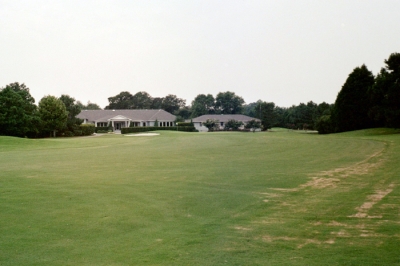 |
| The clubhouse provides a low profile backdrop to the green at The Pointe's par four 9th hole. |
On your way back to the clubhouse after holing out on the eighteenth green, you'll probably feel pretty good about your just-concluded round. Even if you didn't record a career round, you'll look forward to the next time you go around The Pointe.
In addition to an eminently playable 18-hole course, The Pointe features an excellent practice facility. The 30,000-square foot grass teeing area and expansive range permits you to hit every club from driver to wedge. The chipping green offers practice from both fairway-cut and rough-cut length grass. There is also a separate practice bunker and practice putting green.
A word to the wise: Arrive far enough in advance of your tee time to visit the practice green. You'll appreciate getting a feel for the speed of the greens before you have to start writing down your score.
The Pointe Golf Club is a member of the Outer Banks Golf Association. Golf packages with overnight accommodations can be arranged by calling 800-916-6244. Information is available at www.outerbanksgolf.com.
Details:
The Pointe Golf Club
The Pointe Golf Club Drive
Powell's Point, NC 27966
Phone: (252) 491-8388
Website: www.thepointegolfclub.com
Course Architect: Russell Breeden
Head Golf Professional: Doug Kinser
Superintendent: Jay Brown
| Tees | Yardage/Slope | Rating |
| Gold | 6343/127 | 70.3 |
| Blue | 5911/122 | 68.1 |
| White | 5426/117 | 65.8 |
| Red | 4862/119 | 67.9 |
Rates:
Rates vary according to season, ranging from $29 in winter to $79 in the summer season, which runs from June 16th to August 17th. Twilight and reduced replay rates are also available. All rates include golf cart and green fee. Rates are subject to change without notice. Consult the website for more information.
| Related Links | Comments on this article? | |
|
Maryland National Golf Club Hollow Creek Golf Club Rocky Gap Resort PB Dye Golf Club in Ijamsville Whiskey Creek Golf Club |
E-mail Jeff Rendall, Editor: jrendall@golftheunitedstates.com |












